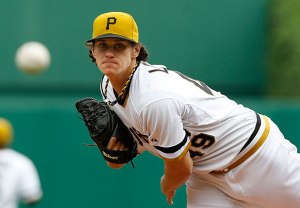Do the Pirates Have What it Takes?
The Pittsburgh Pirates are once again off to a hot start. The owners of a 53-34 record, good for second in their division, the Pirates are looking to finish 2013 in the style they hoped to finish 2012. If current trends are any indicator, Pittsburgh should have no problems locking up their first playoff birth since 1992.
The biggest strength that the Pirates have this year is pitching, although it wouldn’t seem that way when looking at the starting rotation. Entering the season, Pittsburgh’s starting rotation consisted of A.J. Burnett, Wandy Rodriguez, Francisco Liriano, Jeff Locke, and James McDonald. The first three names of that list are the most recognizable but also came with the most uncertainty at the beginning of the season. Burnett entered the season at 36 years old. Wandy Rodriguez is 34. And Francisco Liriano has always been known to have streaks of greatness that are perpetually stalked by an inability to throw strikes. McDonald was going to be a solid mid rotation guy, and Locke, with half a years experience, would attempt to fill out the back end.
Once the season got underway, all expectations were exceeded and the rotation proved to be a dominating force. Burnett showed that the Fountain of Youth filters out of the Allegheny River, pitching to a 3.12 ERA and 10 K/9 in 14 games. Wandy drank some of the same stuff and produced equally strong numbers. But the real stories went to both Francisco Liriano and Jeff Locke.
Liriano was a high risk/high reward acquisition that many assumed would do far more damage to the team that dared take a flyer on him. But so far, he has been magnificent. Through 10 starts, Liriano has posted a 2.23 ERA and a 9.9 K/9. While the walk rate remains high on the higher end of the spectrum (3.41 BB/9), he is still well under he previous two seasons, which both had a BB/9 ration of 5. While it’s hard to apply the decreased walk rate to any one thing in particular, Liriano will continue to be an asset to the Pirates if that walk rate stays down.
Locke, who has been equally as dominant this year, has a different set of concerns. While on the surface his 2.06 ERA and 7-1 record look remarkable, some of his other numbers raise some questions. So far this season, Locke has been very fortunate to strand a large amount of runners on base. He currently stands with a 85.6% strand rate, which is unsustainable for any big leaguer. Locke has also given up fewer home runs than his fly ball rate would support (8.2%), another reason for second half regression considering it is far under his career average. As both of these stats return to the norm, Locke will see his ERA climb closer to his xFIP of 4.11. Even with this regression though, Locke should continue to contribute to the Pirate rotation in a meaningful way.
There is no denying the strength of this rotation. The pitching staff that is 1st out of all major leagues when it comes to team ERA (3.11) and opponent batting average (.225), and third in baseball in WHIP (1.19). But strong rotations tend to get teams only so far before injuries and bullpens cost the team wins. The Pirates have already been faced with these challenges this year and have proved that they have depth, both in the minors and in the pen, which make up for the doubts within their rotation.
So far this season, the Pirates have had to fill their rotation after injuries left them with holes. First they turned to Jeanmar Gomez who after starting eight games, currently sits with a 2-0 record and a 2.76 ERA. They also were forced to turn to highly touted prospect Gerrit Cole, who started his career off 4-0.
The bullpen has also been one of the safest late inning bets in the MLB. Jason Grilli leads the NL in saves and is 27-28 in save opportunities. Before Grilli enters in the ninth, the Pirates have the best set-up men in the game. Mark Melancon has and ERA and WHIP just above 0.8 in 41 innings. The rest of the bullpen combines to have an ERA of 2.92 and an opponent batting average of .217. The strong bullpen helps to fill in for the starting rotation which averages just over 5 1/3 innings per start.
The Pirates second half will not be as good as their first half. The starting rotation will continue to be tested and there will be some regression for Locke and the questions with Liriano will remain. But the Pirates have proven that they have the depth to overcome any pitching problems that may arise.

The worst thing to happen to the Pirates this year


